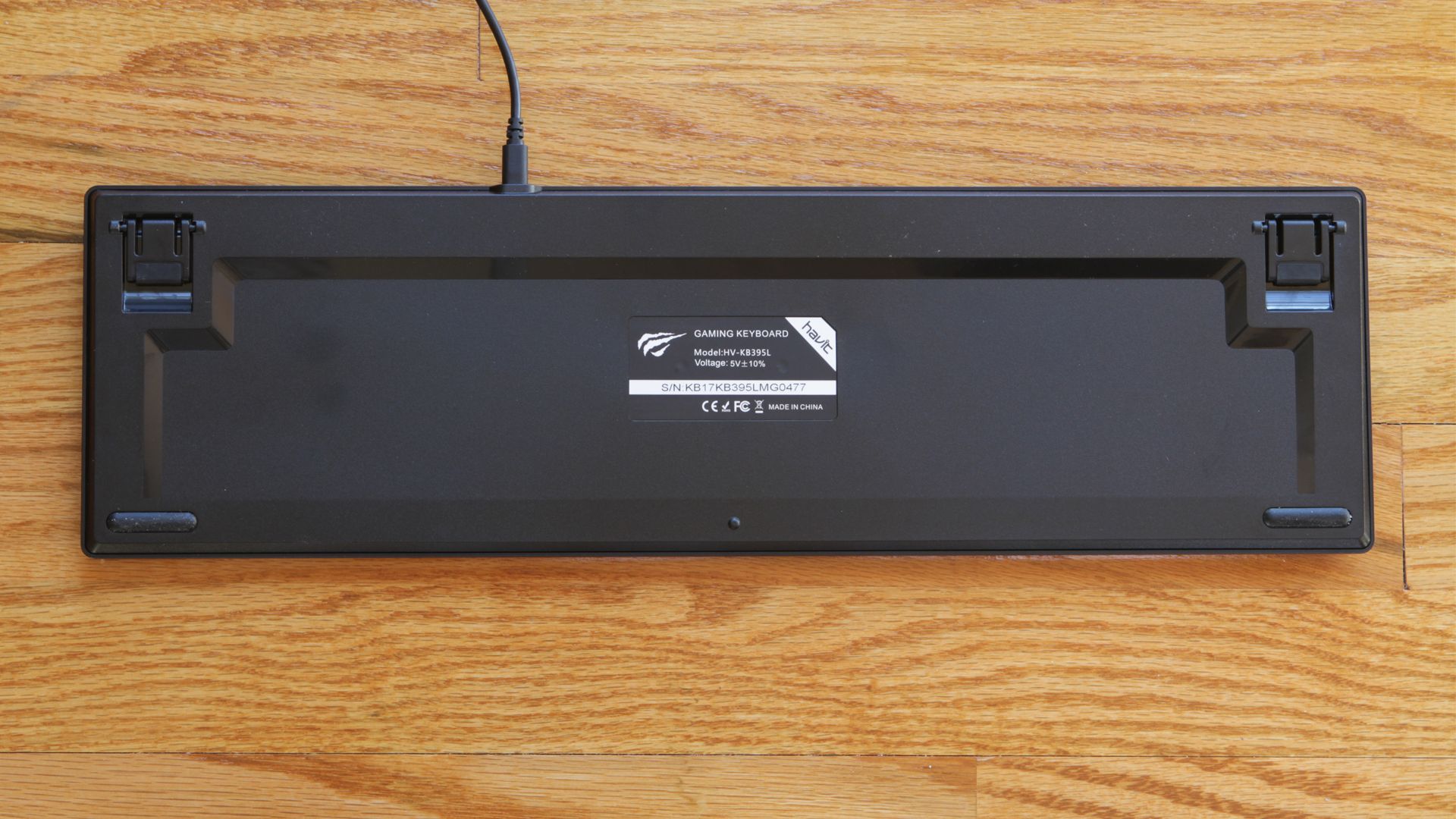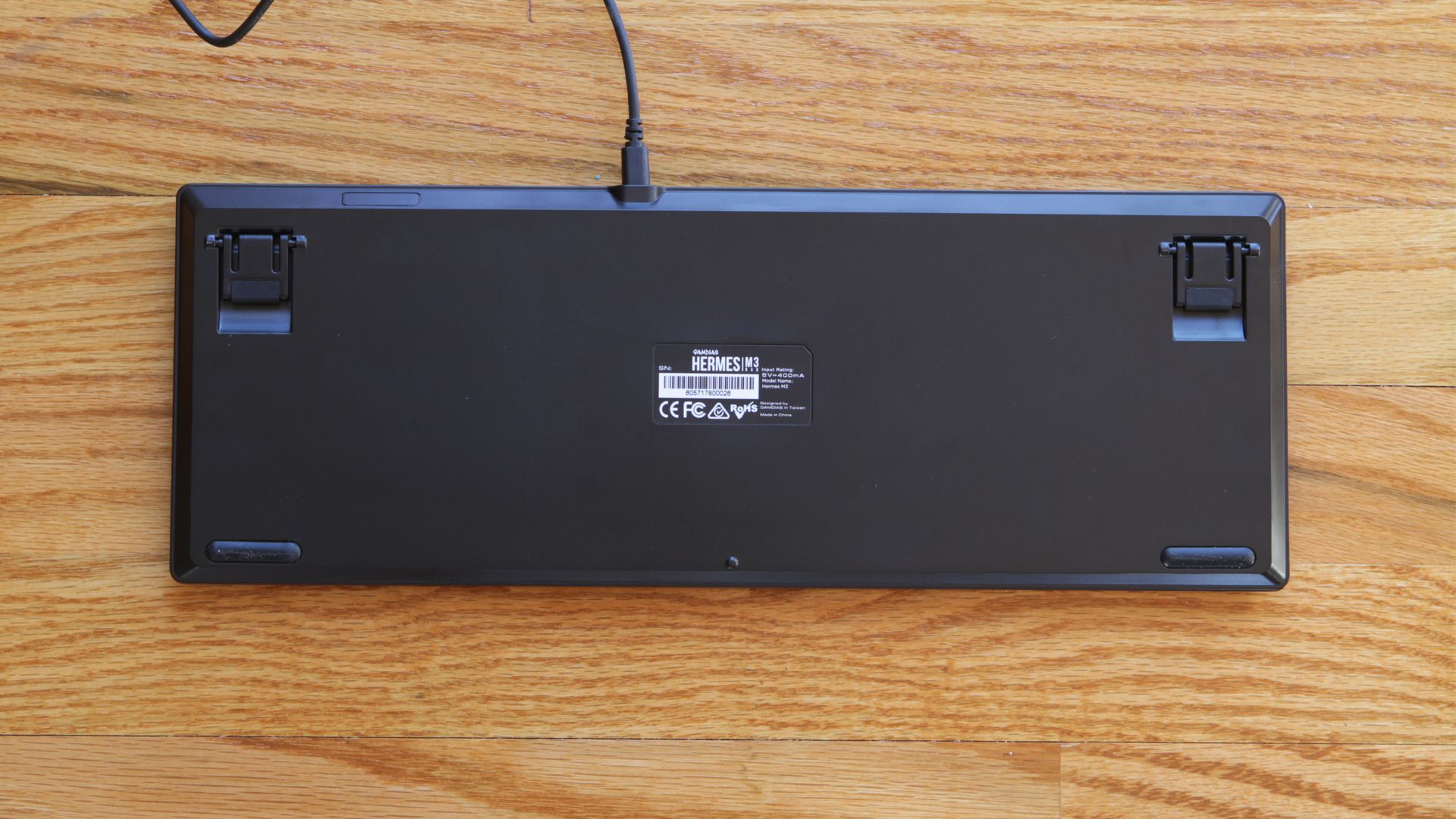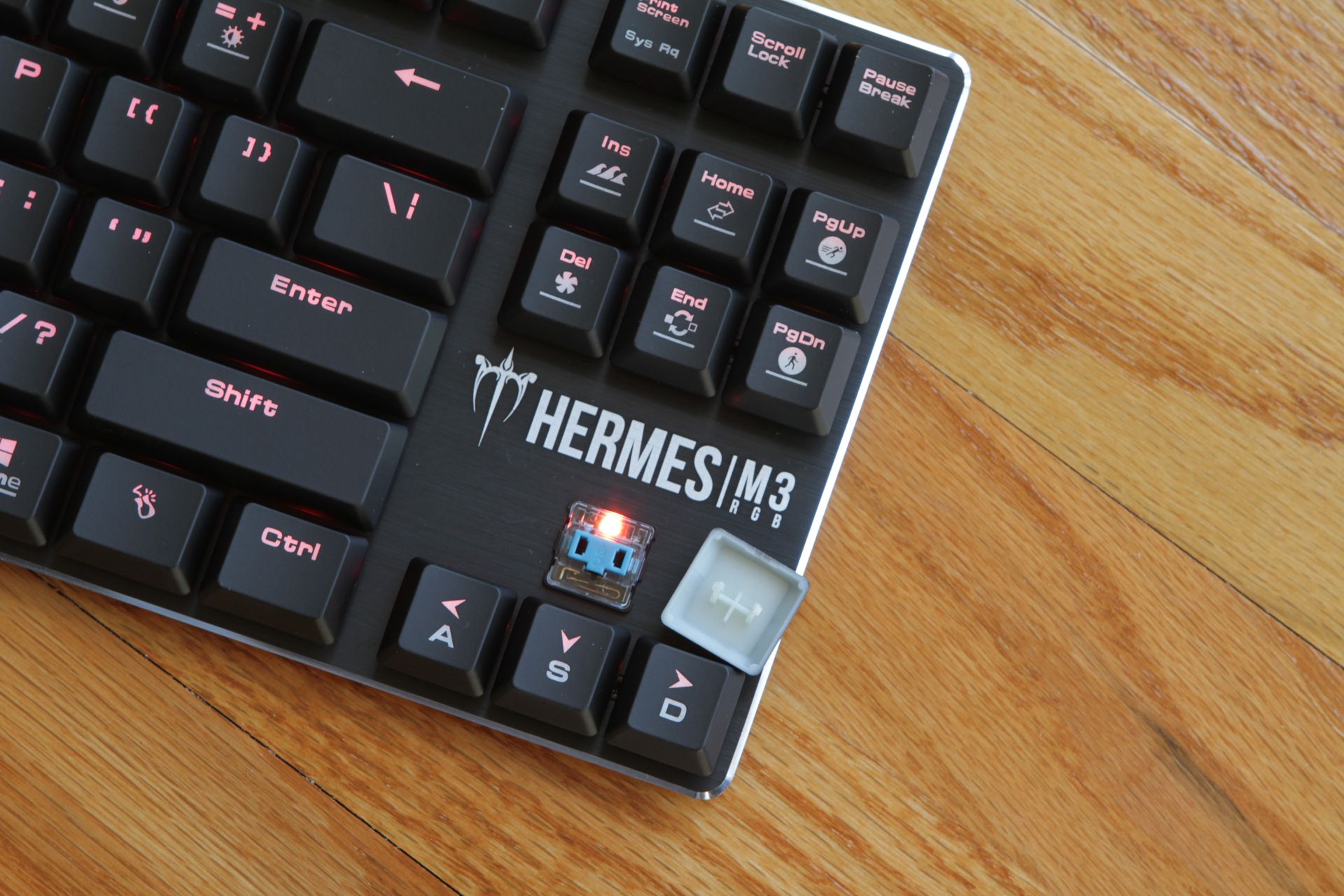Kailh Low-Profile Switches: Havit KB395L And Gamdias Hermes M3 RGB, Hands On
One of the biggest trends in keyboards these days is the proliferation of low-profile mechanical switches, and now that we’ve been able to spend some time with multiple low-profile keyboards, we believe that it will only become more controversial. And that’s because we’ve discovered that when it comes to low-profile mechanical switches, you’ll either love them or hate them.
Primarily, the low-profile options on the market all have exceedingly short travel, which results in a lighter typing feel despite the fact that the weights for some are relatively high (50gf, 60gf, etc.). That light feel will drive some people nuts. However, there’s a growing chorus of users who have quietly been clearing their throats and noting that they actually kind of like typing on their chiclet-style laptop keyboards just as much as a desktop mechanical plank, but gee, wouldn’t it be nice to have short mechanical switches under those caps?
If you’re one of those people, we have great news for you: Typing on these keyboards is your low-profile dream come true.
We’ve been treated to a handful of gaming laptops tricked out with low-profile mechanical switches, but now we have them on standalone keyboards, too. We have just two keyboards in-house that have them--the Havit HV-KB395L and the Hermes Gamdias M3 RGB--and both sport Kaihua’s PG1350 switches.
MORE: Teardown: Kailh Low-Profile Switches
Havit HV-KB395L
When we first plopped the Havit HV-KB395L onto our desk, a few things struck us immediately: First, the thing slides around like crazy. It’s quite light (that was the second thing we noticed), which doesn’t help, but it also lacks rubber feet at the top part of the underside of the keyboard (there are two on the bottom part). If you want stability, you’ll need to flip out the rubber-tipped feet, but we found that doing so pitched the KB395L at an uncomfortable typing angle.
The keycap font is also striking because the characters are enormous. We were a little surprised to find a full-size, 104-key layout--one would think that it makes more sense to pair a slim and light design with a smaller footprint--but Havit does offer another keyboard, the KB390L, that has the TKL form factor and the same switches.
Get Tom's Hardware's best news and in-depth reviews, straight to your inbox.












Often when we begin evaluating a new keyboard, it takes up to a day or more to get comfortable with it. We frequently pivot from a keyboard with one distinct type of switch to another--on purpose, to get a clearer feel for each new plank--but doing so can be jarring and often slows down our typing for a while. Not so with the KB395L; it took us just a few minutes to adjust from a mechanical keyboard with standard-size switches to this low-profile model. If anything, our typing speed picked up after just five minutes with this thing. By design, it seems to demand a lighter touch, and that translated into fleeter-fingered typing.
The speed was further aided by the fact that the keyboard and keycaps are also lower-profile than a more standard board, which let us position our hands flatter than usual. A good wrist rest will offer this same advantage on a more standard-sized keyboard, of course. The KB395L doesn’t have one, but with such a flat profile, you don’t need one.
With all of the above, you also get that satisfying Blue-switch click. Well, most of that satisfying Blue-switch click. The click of the Kailh PG1350 is lighter and higher-pitched than the standard Kailh Blue switch, and across an entire keyboard’s worth of switches, the difference in typing sound is notable.
This is where we insert the disclaimer that the above is quite subjective. We enjoy the feel of a wide variety of switches, and that includes many lighter switches. But that’s not true for everyone; some people can’t stand anything under 60g, for instance. Others love or hate clicky Blue switches. And so on unto infinity.
That is all to say that this light, clicky, swift, flat typing experience is a particular one that will not appeal to everyone. But it’s perfect for a certain type of, er, typer.
When it comes to gaming, our opinion of the KB395L is less effusive. Don't get us wrong, it’s all there--the solid, consistent feel of the mechanical switches, the click, etc.--but it’s just missing that je ne sais quoi. Ironically, that light and breezy feeling that makes the typing experience so fluid and fast feels lacking in the heat of an FPS battle. We noticed this most clearly any time we typed into the in-game chat--suddenly, there was that lovely lightness again--and then when we went back to WASD-ing, that pleasant sensation evaporated. However, we never had any issues with accidental keypresses despite the shallower travel, neither while typing nor while gaming.
With thin switches comes a thin chassis, and indeed, the KB395L is slim at just 8.35-13.45 mm. Unfortunately, the thinness comes at a cost: The KB395L has terrible flexion issues. If you bang especially hard on the keys, you can feel and see the keyboard bend in the middle. To be frank, it didn’t both us all that much--and if you type like a normal, non-angry person, you won’t have a problem there, but the keyboard does feel a bit flimsy. (The Gamdias Hermes M3 RGB suffers less here because its chassis isn't as wide and is thus stronger in the middle.)
The switches are top plate-mounted, too, which let Havit essentially build the KB395L with a top plate/PCB and a thin bottom--two pieces with almost no space in the middle. The top plate is aluminum. That flat, dense construction, combined with the lighter switch click, makes for a fairly subdued auditory experience. If you bend down and listen closely, you can hear the switches ping-ping-pinging, but there’s just nothing to amplify that noise. (Some keyboard designs put the PCB and switches into a bowl-like lower chassis that reflects all those little noises right back at your face.)
The KB395L has accompanying software that should unlock features such as macro recording, lighting adjustments, and more. You do get plenty of onboard lighting controls, too.
Gamdias Hermes M3 RGB
Perhaps a little more appropriate for the slim design, the Gamdias Hermes M3 RGB comes in a TKL form factor, resulting in a completely compact little keyboard. Given the fact that the chassis of the KB395L and Hermes M3 RGB look almost exactly the same (although they have slightly different heights), employ a removable micro USB cable, have nearly identical keycaps (although with different fonts), and use the same switches, the typing feel on these two planks is strikingly similar.
Of course, the Hermes M3 RGB is even lighter by dint of the smaller form factor. In terms of evaluating the subjective typing performance, gaming performance, and noise profile of this keyboard, we’d simply echo everything we said about the KB395L. Indeed, these keyboards are two peas in a pod.










The Hermes M3 RGB enjoys the support of Gamdias’ Hera software, which lets you handle lighting configurations and programmability. You also get some onboard controls to execute your macros, as well as other perks. The LEDs on both keyboards appear suspiciously dim; they actually may be the same LEDs, and controllers, too. But that’s neither here nor there for now.
It’s worth noting that Gamdias has another low-profile switch keyboard in its stable, the Hermes P3 RGB, which has Gamdias-branded low-profile switches (Blue/Brown/Red/Black).
Keycaps And Stabilizers
And of course, following the thinness, the caps themselves are lower-profile than normal. The keycaps on the KB395L and the Gamdias Hermes M3 RGB are almost exactly the same size, as you can see in the chart below. Compare those to a more full-height cap that's 8.3-10mm tall, and you get a sense for how slim they really are.
| Header Cell - Column 0 | Havit HV-KB395L | Gamdias Hermes M3 RGB |
|---|---|---|
| Switches | Kailh Blue PG1350 | Kailh Blue PG1350 |
| Chassis Height | 8.35-13.45mm | 8.6-13.58mm |
| Keycap Height | 4.2-6mm | 4.67-6.35mm |
| Weight | 570g | 540g |
The other obvious difference between these caps and full-height caps is that these are not Cherry MX-compatible. This is because the switches don’t have the Cherry cross stem design. Instead, they have parallel slots, and the keycaps have two little arms that fit into them. For as small and thin as those arms are, the caps feel quite sturdy. They wiggle a tad, but certainly not any more than caps on Cherry MX-style switches. These particular keycaps are ABS plastic with translucent lasered legends.
As you can see in the images, these two keyboards employ the same stabilizers--a wire bar onto which the keycaps snap. However, although this is in some ways a Costar-like stab design, it’s a bit simpler. Usually what you’ll see is a metal wire whose ends are bent inward and slot into two little plastic pieces that are snugged up into the keycap.
However, on both the Havit KB395L and Gamdias Hermes M3 RGB, there are no additional plastic bits, and the wire doesn’t have bent-in ends. Instead, the stabs make a simple U shape, with two arms that slot into little notches on the keycaps. For added stabilization, the keycaps have two thin posts that fit into guide shafts.
People have wide-ranging opinions on stabilizers; some can’t stand what they call the “mushy” feel of Cherry-style stabs, whereas others despise the feel and sound of Costar-style stabs. (And every permutation of preferences you can imagine.) Thus, again, our evaluation of the stabilizers on these two keyboards is highly subjective, but we found that they offer a consistent feel compared to the rest of the keys and introduced no additional noise.
A Good Start
If you’ve been eagerly anticipating low-profile keyboards and the low-and-light typing feel they promise, we can attest that these first offerings should please you, for the most part. Basically, if you like typing on a laptop keyboard but want an experience that’s superior to the standard laptop scissor switch / rubber dome design, these planks are for you. (If not, run far, far away from them.)
However, we found that for gaming, we missed the meatier feel of a full-height switch. Further, both the Havit KB395L and Gamdias Hermes M3 RGB--which are nearly identical in terms of construction and overall design--have plastic elements that make the chassis feel a little cheap, and they slide around too much on the desktop.
We wonder how much more attractive keyboards like these would be with higher-end features such as all-metal chassis, PBT keycaps, and more elegant lighting and configuration options. Indeed, a stronger chassis material could go a long way towards reducing the flexion of these keyboards.
Also note that the Havit model is just $80, whereas the Gamdias Hermes M3 RGB is available for $130, which is a striking difference. If you’re pining for the smaller form factor and want to pay (a lot) less than the Hermes M3 RGB costs, Havit’s 87-key KB390L is just $64.
However, taken as a whole, Havit and Gamdias have proven that a standalone keyboard with low-profile switches is a viable entry into the pantheon of mechanical keyboards. If nothing else, it’s a great start. We expect to see more low-profile mechanical-switch keyboards emerge over the course of the next year.
| Header Cell - Column 0 | Havit HV-KB395L | Gamdias Hermes M3 RGB |
|---|---|---|
| Type | Full-size (104 key) | TKL (87-key) |
| Switches | Kailh Blue PG1350 | Kailh Blue PG1350 |
| Lighting | RGB | RGB |
| Onboard Storage | Unknown | Up to 6 profiles |
| Media Keys | Yes, but not dedicated | Yes, but not dedicated |
| Game Mode | Yes | Yes |
| Microcontroller | Unknown | 32-bit ARM Cortex |
| Key Rollover | NKRO | NKRO |
| Polling Rate | Unknown | 1,000Hz |
| Interface | Micro USB (keyboard end), USB Type-A (2.0, PC end) | Micro USB (keyboard end), USB Type-A (2.0, PC end) |
| Cable | 1.5m, detachable | 1.5m, detachable |
| Additional Ports | No | No |
| Keycaps | Laser-etched legends on ABS plastic | Laser-etched legends on ABS plastic |
| Construction | Aluminum, plastic | Aluminum, plastic |
| Accessories | -- | -- |
| Software | Yes | Yes, Hera |
| Dimensions | 436 x 126 x 22.8mm | 354 x 128 x 25mm |
| Weight | 570g | 540g |
| Warranty | Unknown | Unknown |
| Misc. | Win 10/Win 8/Win 7/Vista/Mac/Linux (Driver software not compatible with Mac & Linux) | WASD & arrow keys swap |
| Price | $80 MSRP | $130 (street) |
Seth Colaner previously served as News Director at Tom's Hardware. He covered technology news, focusing on keyboards, virtual reality, and wearables.



